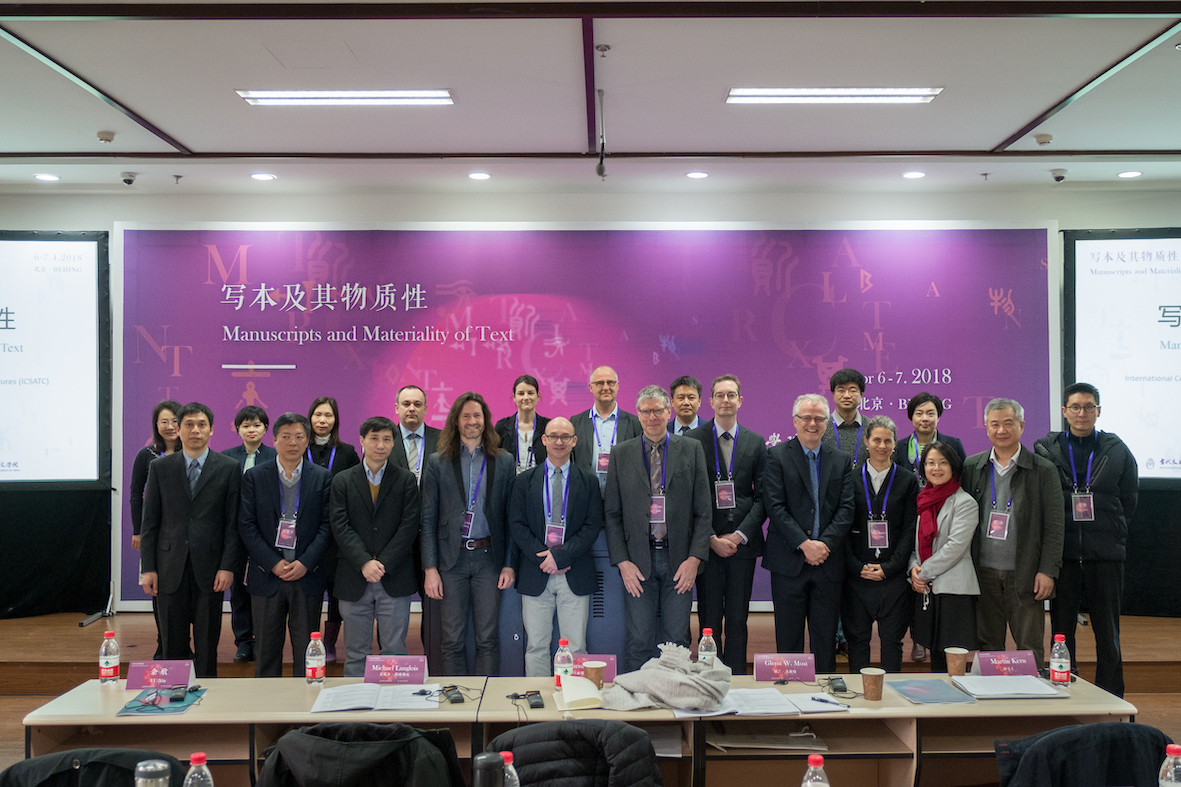The Second International Conference: Manuscripts and Materiality of Text
发布时间:2018-04-07By Don Kuang (Renmin University of China), Zheng Yilin(Peking University), Callisto Searle (Renmin University of China)
From 6th-7th April 2018, the International Center for the Study of Ancient Text Cultures (Renmin University of China) hosted the second international manuscript culture conference on the theme of “Manuscripts and Materiality of Text,” at Renmin University of China (RUC) in Beijing. 15 distinguished scholars from the fields of different civilizations presented speeches on manuscript culture. The conference began with a welcome speech by the Director of the Center, Professor Martin Kern (Princeton University) and the vice Director, Professor XU Jianwei (RUC).
Working on manuscript studies of ancient China, professor Martin discussed varying traditions, the present situation and future expectations for manuscript research East and West. Because of the diversity of language systems and cultural traditions, the definitions of “Manuscript” are quite different under the context of the East and the West. There still remains great swathes of opportunity for Chinese textual-social study, for instance of textual production, usage and pattern of transmission, while comparing to and drawing experience from the West. Because of the recent trend towards the study of materiality, it is inevitable that observation into the material process of textual production and transmission will with no doubt shed light to revolutionary understanding of all ancient texts. The idea of “Materiality of Text” transcends the textual particularity of any civilization and raises universal questions for ancient texts from all over the world, providing a new perspective for cross-cultural comparison. Professor Kern asked the audience some key questions about the study of “Manuscripts and Materiality of Text”, they are: how do we think about genres among manuscripts—not just in terms of their texts but also in terms of their carriers? How are different genres being read and received differently, by different audiences, and are hence also produced with different sets of expectations? Who are the communities to whom these manuscripts matter? Who and what are “scribes”—a word and cultural function for which we do not seem to have a single good equivalent in Chinese antiquity? How do we address the tension between textuality and codicology?
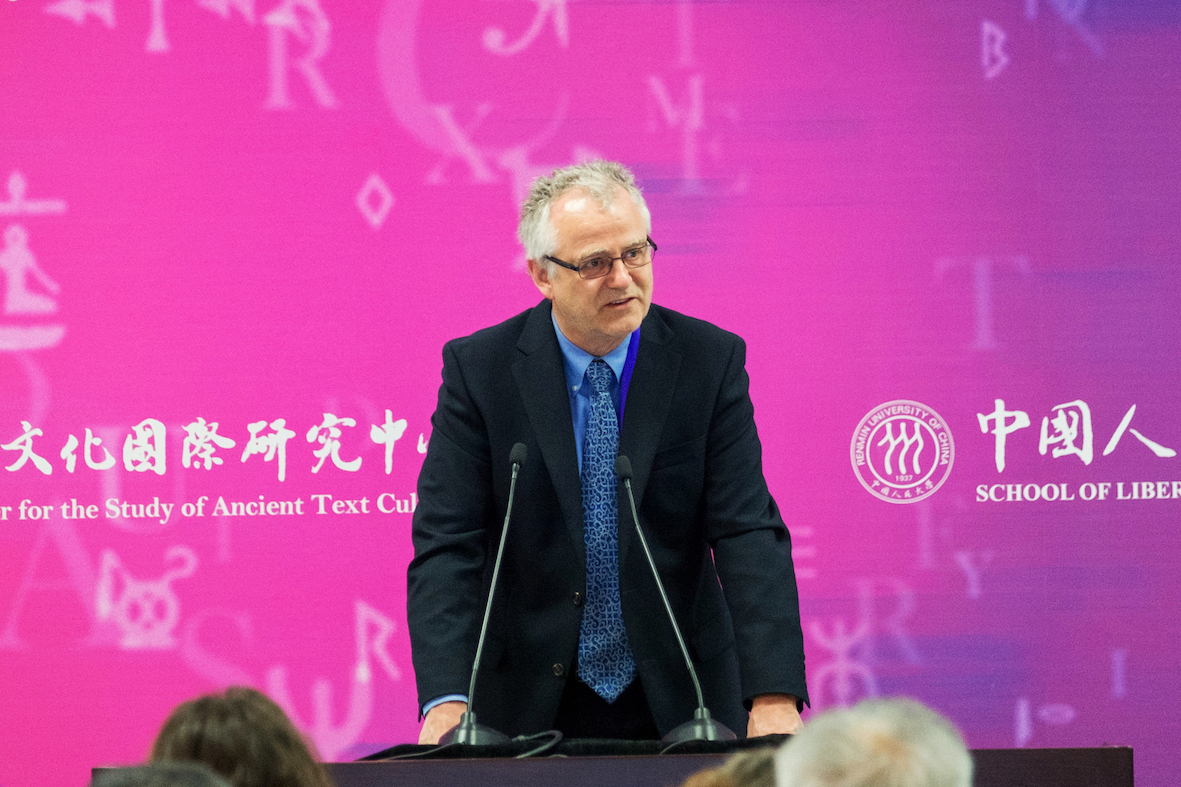
Professor XU Jianwei presented the goal of the center that is to compare and study textual culture. He hopes that different academic traditions of the East and the West will come into each other’s perspective by the this communication between ancient Egyptian, Biblical and Chinese manuscripts. The traditional method of studying the Chinese classics mixes hermeneutics systems of all historical stages, which constructs a history via contemporary understanding. That is why we need to turn to textual study, which is the only way to clear out the multiple layers added by various historical stages, to go straight back to the original state of the text. To achieve a full understanding of textual construction, logic and the formation of textual-expression, we have to reconstruct the scene of textual production, writing conditions, transmission process and how people use them.
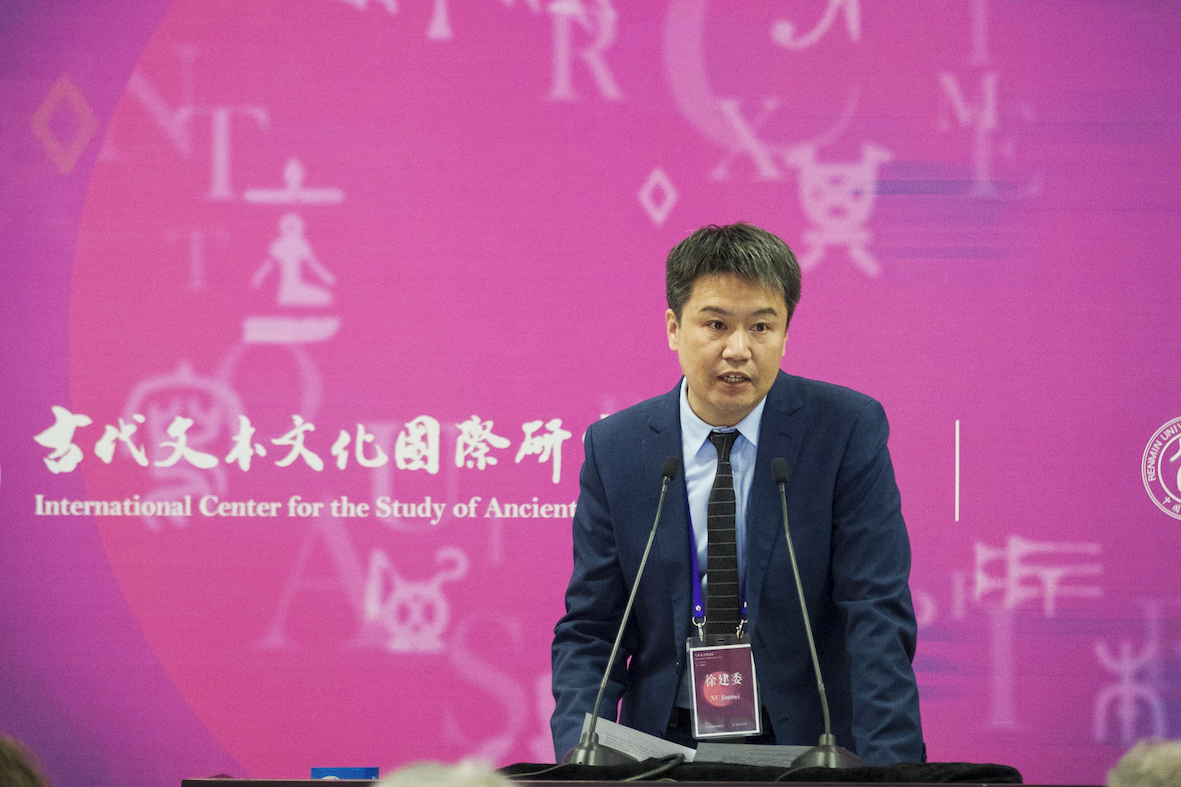
Some of the scholars who presented next focused on various aspects of Chinese manuscript study, including the principle of writing during transcribing, scribal hands, development of character, or manuscript as the media for spreading religious material, and the cultural function of manuscript.
Professor XU Jianping (Zhejiang University), by observing the material nature of the P.2643 Shangshu manuscript housed at the National Library of France, suggested that the manuscript might be written by the turn of the Sui dynasty and the Tang dynasty. He also explained that the red, black and brown notation marks are layers created by diverse readers of later periods. Last, by identifying the traces made by later readers making corrections to the Ligu characters, he suspects that the version of Shangshu dedicated to Mei Ze might be written completely with Ligu characters, which are gradually rectified by later readers through the transmission process.
Professor Chen Wei (Wuhan University) reviews a special writing format that is different from the traditional style of “straight down”, namely the style of Pangxing Xieshang. It is generally accepted that pangxing means an alternative form of writing in columns, but so far there is no agreement on the meaning of the xieshang writing format. By analyzing various tables in the Records of the Grand Historian and the Book of Han, we suggest that xieshang indicates a relationship between writing and reading when one reads related information in a diagonal direction. The census registrations in the Liye Qin bamboo slips as well as some later genealogies, provide similar valuable clues to support this theory. Xieshang is the appropriate form (i.e., as a tree diagram or table) to illustrate the complex lineage relation of a family, tribe, or ethnic group in history books.

Transmission and material form were also the topic of the presentation by Professor Christopher M. B. Nugent (Williams College). He takes the manuscript copy of the children’s primer entitled Kaimeng yaoxun (Important Instructions for Beginners) as his example. The book is seen in many places of Dunhuang, and may also be found in a late ninth-century catalogue of Chinese books in Japan—Nihonkoku genzaisho mokuroku, while being absent from all the bibliographic records outside of Dunhuang. He believes that the book was popular for a period, however it disappeared over history due to some unknown reasons. Professor Nugent observes the punctuation marks and implication of pronunciation of characters on the manuscript P.2578, which is held now in the Pelliot collection at the Bibliothèque National de France, and tries to reconstruct the possible scene of usage. The multiple complicated words used in the manuscript, which is beyond the need of normal businessmen and peasants, implies that it is more likely used by the intellectual rank for purpose of poem composition.
Professor Imre Galambos (University of Cambridge) explained that traditionally Chinese script did not mark word boundaries, but is written continuously without indication where one word ends and another begins. Since individual characters are clearly separated and each of those denotes a separate word, this is less of a problem than in the scriptura continua of alphabetic writings. Thus on the most basic level, the logographic nature of the Chinese script is a relatively reliable device for word divisions. He finds that, through observation into unofficial manuscripts in Dunhuang, some scribes have created methods to mark multisyllabic words, making them stand apart from their immediate environment. These methods includes adding similar semantic components, marks to imply linked characters and mixing two characters into one. However, further study is needed to push the understanding of manuscript in Dunhuang forward.
Professor Matthias L. Richter (University of Colorado at Boulder) focused on how the distinction of scribal hands and other judgments concerning degrees of similarity of handwriting play an important role in the interpretation of early Chinese manuscripts. Yet, there is little agreement with regard to the terminology (whether Chinese or English) used to distinguish and describe such degrees of similarity. His research aims to delineate the categories of ‘scribal hand’, ‘style’, and ‘type’ of script in distinction from one another. He explored the criteria for the identification of scribal hands and styles of script and considered to what extent a collectively shared style of script can yield similarly valuable information for the understanding of a manuscript’s production and its appropriate interpretation as is usually couched in terms of identifying individual scribal hands.
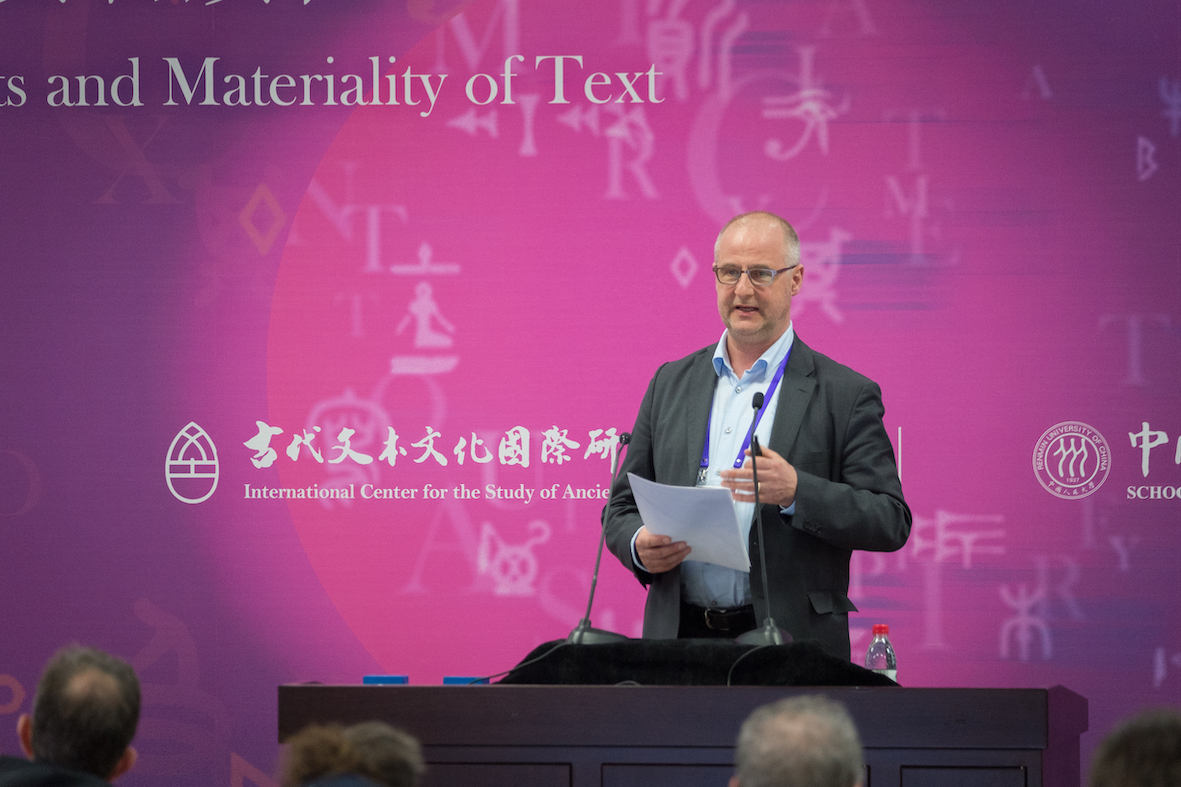
Professor Rong Xinjiang (Peking University), started out from the perspective of material carriers, to explore how books and records, as culture, were transmitted along the early Silk Road. Buddhism was primarily transmitted orally by monks to China, thus, they did not have to carry heavy sutras written on pattra-leaf to achieved transmission. Thereafter, from Wei and Jin dynasties to the Tang dynasty, some Chinese monks started to go west pursuing Buddhism and made copies of the Buddhist texts in Central Asia and India. The light and portable paper invented by China made great contribution to this movement. Chinese books and records were initially written on bamboo and wooden slips, which were not convenient to transport. The lighter material, silk, was just too expensive for large scale transmission. The invention of paper, thus greatly promoted the progress of Chinese culture to the West during the Wei, Jin, Sui and Tang dynasties. Undoubtedly, high-grade silk scroll scriptures, along with Chinese traditional stone rubbings, transcriptions and even steles erected in Western Regions were also devices for Chinese culture to travel West. He also explored examples of books and records discovered in north-west India, Central Asia and the Hexi Corridor, and try to demonstrate how bamboo or wooden slips and pattra-leaf scriptures were replaced by paper manuscripts, and discussed the differences of textual structure, length and content between various carriers, so as to explain how knowledge of diverse civilizations were progressively exchanged along the Silk Road.
Professor YU Xin (Fudan University) defines sutra wrappers, sutra kerchiefs, sutra cases, and sutra desks as “sutra devices” and investigates various primary sources: the archaeological remains discovered in the Library Cave at the Mogao Grottoes in Dunhuang, the Ruiguang Pagoda and Huqiu Pagoda in Suzhou, as well as in the National Museum in Nara; historical records and Buddhist prayers in Dunhuang manuscripts and traditional texts; murals from the tombs of Liao dynasty and the Buddhist temple of Yuan dynasty, paintings on silk from Tang to Ming dynasty. By analyzing their shapes, material structures, practical functions and religious meanings in reading performances, dignifying rituals, and making offerings, Professor Yu discussed the ideas behind their production and artistic representation in Buddhist paintings and literati paintings. This study intends to develop a comprehensive understanding of the role of “sutra devices” in the representations of textual and visual knowledge, religious rituals, and the formation of the Chinese Buddhist Canon tradition.
Other scholars from the fields of western manuscript culture lead the audience to explore topics on the culture of other ancient civilizations: some, from the aspect of materiality, focusing on the value of early Egyptian textual amulets, early Western classics or official documents in cultural history, while others explored the writing format and condition of early Western manuscript from spatial and temporal dimensions.
Professor Jacco Dieleman (independent scholar) investigates the material properties of textual amulets from Ancient Egypt in order to reconstruct the social history of ritual specialists and knowledge transfer. Textual amulets are short apotropaic texts inscribed on linen, papyrus, or metal foil, which when folded or rolled and tied with a piece of string were worn around the neck for protection in daily life. Such artifacts have been found across the ancient Near East and Mediterranean, inscribed in various languages with a variety of apotropaic designs. Differences in design and usage between the various regions and across time suggest that the practice started in Egypt as early as the Bronze Age, later finding its way into the Levant and across the Mediterranean in the Iron Age. Changes in formatting, folding patterns, and suspension methods are all discussed, exploring what they might have to say about transformations in scribal culture in ancient Egypt.
Professor Michael Langlois (Université de Strasbourg) focused on the oldest manuscripts of the Hebrew Bible, which were found at Qumran and on other archaeological sites near the Dead Sea. While some of them preserve a text quite close to that of the biblical textus receptus, others exhibit differences that shed light on the redaction of the Bible, proving the assumption that there exists an alternative lineage of the text. Through computer simulation, Professor Langlois re-dated the Hebrew Bible and assumes that by editing the text whilst transcribing, the scribes indirectly “write” or “create” the text. He also discussed questions such as how representative are they of the communities that produced the Bible? What do they tell us about the materiality of the biblical text? And what is the philological approach underlying modern editions of these scrolls and the Hebrew Bible?
Professor Marina Rustow (Princeton University) presented the audience with a single manuscript, an early eleventh-century paper rotulus that originally formed part of a decree from a Fatimid caliph at Cairo to a local Egyptian official. She explains that within decades, a Jewish scribe in Fustat, Egypt acquired the decree and used it as a writing support for his own idiosyncratic recension of a seventh-century Jewish legal commentary. This is the reason why this manuscript and hundreds of other Arabic decree fragments have survived, preserved for posterity only by the scribes who reused them for texts in Arabic, Greek and Hebrew script. Professor Rustow argues that reused state documents offer us a parallax view of documentary ecology and archiving practices that well-organized archives cannot - with implications for the shape, scope and scale of medieval Islamic polities.
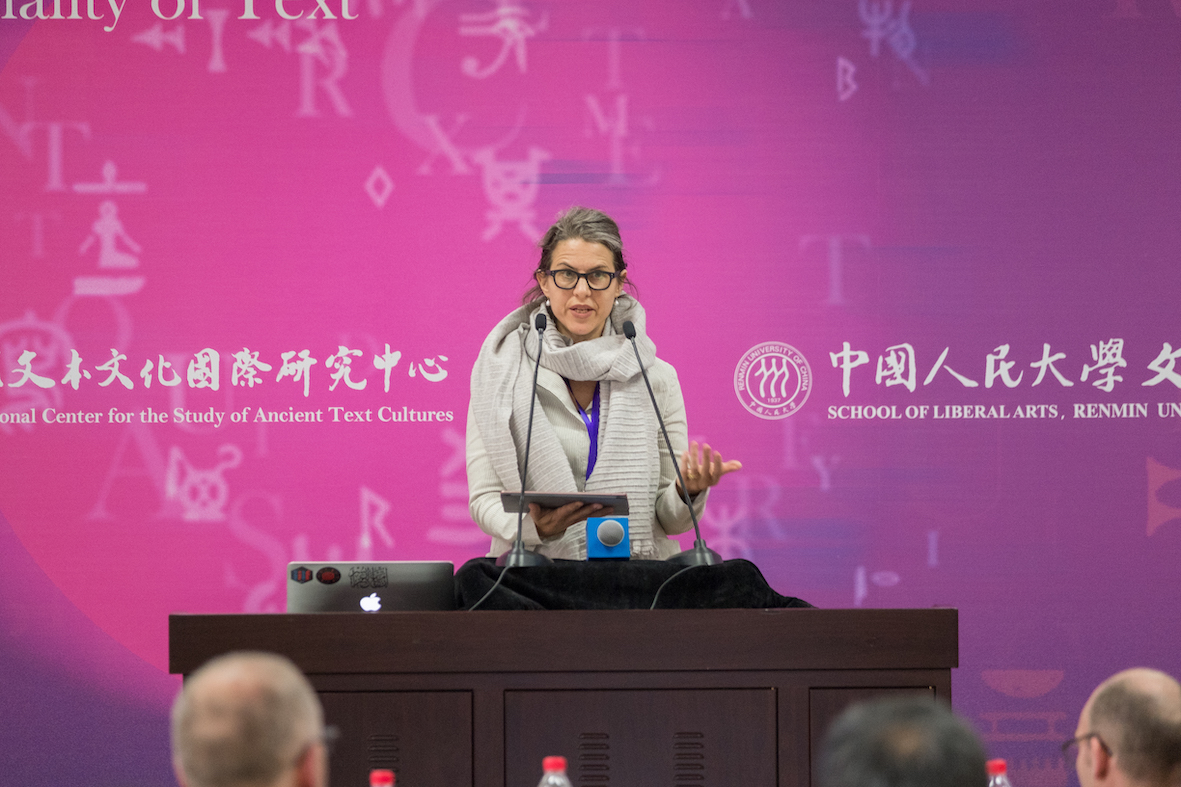
Professor Glenn Most (Scuola Normale Superiore di Pisa) began with an exploration of some of the spatial and temporal complexities that are involved in a traditional form of impagination in the Western tradition in which a centrally situated text is accompanied by surrounding paratextual materials (e.g., commentary, critical apparatus, translation, footnotes, etc.). He then goes on to consider the development in modes of impagination from earlier ancient Greek and Roman layouts, mostly on papyrus and in rolls, to late ancient ones, mostly on parchment and in codices, and explores questions such as to what extent the specific nature of the materiality of these bearers of the texts and paratexts might have played a decisive role in this development and to what extent other, social and psychological, factors may have been involved.
The last three scholars drew the audience’s attention to the current situation and difficulties of manuscript study, as well as to future expectations, from a methodological perspective.
Professor Verena Lepper (National Museum Berlin/ Humboldt-Universität zu Berlin) notes that located in the Nile on Egypt’s southern border, Elephantine must have been such as important island in terms of military strategy and trade, as no other settlement in Egypt has been so well documented over such a long period of time through texts. However, 80% of the several thousand papyri and other manuscripts from Elephantine Island in Egypt are spread worldwide and are yet to be published. She notes that some of these texts are hidden in rolled, folded or crumpled documents, most of them precious objects, rather delicate and brittle. She presents some first results of their project accessing papyri in a digital manner using virtual unfolding techniques, which will do no damage to the manuscript artifacts. It is a joint venture of experts in manuscript studies, physics, mathematics, computer science and digital humanities. She revealed to the audience that those texts will give insights to the everyday life of a multi-ethnic, multicultural and multi-religious community.
Professor Daniela Mairhofer (Princeton University) discussed the interplay of textuality and materiality. She distinguishes two different aspects of materiality: the make-up of a book, the writing material and the page lay-out on the one hand; textual ‘accessory’, that is accompanying textual material characteristic of the religious-scholarly world of the Middle Ages, such as marginalia, interlinear glosses, and so on, on the other. She argues that both play an important role in the locating, dating, assessing and understanding of a text transmitted in a medieval manuscript. In some cases, forming a textual entity, where base-text and textual material are inextricably linked, and hence cannot exist separately in an edition. In this context, a late medieval composite manuscript can serve as an example of how entangled material and text may be; of how important it is to pay attention to not only the text of interest, but to basically everything that comes with it; and, furthermore, of how challenging the editing of a Latin text can be if one were to include accompanying textual material in the modern edition, as it might require an adaption in the method of editing.
Professor Lu Yang (Peking University) noted that recently the study of medieval China (including the Tang dynasty) has greatly contributed to our understanding of the history of ancient China. One major characteristic of the study of this period is that the reconstruction of various aspects of medieval Chinese society not only depends on scholarly interpretation of numerous transmitted and excavated sources but also on the investigation of the material property of the medium bearing these writings. He advocates that we must pay attention to how and to what extent a material medium shaped the contemporary perception of the meaning and significance of medieval writing it transmits. Like the impacts that printing had on a written text (especially in terms of consolidation and circulation), we cannot afford to neglect how material mediums of writings affected their content and performance. Professor Lu reflects on the notions of “textuality” and “materiality," as well as the relationship between the two in medieval China studies at a methodological level .

The two-day conference raised lively questions and debate among the audience. Many of the audience members contributed to the discussion by introducing comparative perspectives from their own fields of specializations. The interplay between East and West provided all students and scholars in attendance with new perspectives and methodological ideas. The next international conference will focusing on the King’s Voice: Royal Speech and Inscription in the ancient world, to be held on 11th-13th April 2019, at RUC, Beijing.
